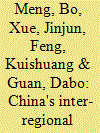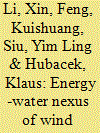| Srl | Item |
| 1 |
ID:
125650


|
|
|
|
|
| Publication |
2013.
|
| Summary/Abstract |
In this study, we apply the inter-regional input-output model to explain the relationship between China's inter-regional spillover of CO2 emissions and domestic supply chains for 2002 and 2007. Based on this model, we propose alternative indicators such as the trade in CO2 emissions, CO2 emissions in trade and the regional trade balances of CO2 emissions. Our results do not only reveal the nature and significance of inter-regional environmental spillover within China's domestic regions but also demonstrate how CO2 emissions are created and distributed across regions via domestic and global production networks. Results show that a region's CO2 emissions depend on its intra-regional production technology, energy use efficiency, as well as its position and participation degree in domestic and global supply chains.
|
|
|
|
|
|
|
|
|
|
|
|
|
|
|
|
| 2 |
ID:
113455


|
|
|
|
|
| Publication |
2012.
|
| Summary/Abstract |
At the end of 2010, China's contribution to global CO2 emissions reached 25.1%. Estimates show that power generation accounts for 37.2% of the Chinese CO2 emissions. Even though there is an increasing number of studies using life cycle analysis (LCA) to examine energy consumption and CO2 emissions required by different types of power generation technologies, there are very few studies focusing on China. Furthermore, the nexus between water consumption and energy production has largely been ignored. In this paper, we adopt input-output based hybrid life cycle analysis to evaluate water consumption and CO2 emissions of wind power in China. Our results show that China's wind energy consumes 0.64 l/kWh of water and produces 69.9 g/kWh of CO2 emission. Given that the Chinese government aims to increase the wind power generation capacity to 200 GW by 2020, wind power could contribute a 23% reduction in carbon intensity and could save 800 million m3 of water which could be sufficient enough for use by 11.2 million households. Thus, given the often postulated water crisis, China's energy policy would reap double benefits through progressive energy policies when increasing the share of wind power as part of overall efforts to diversify its electricity generation technologies.
|
|
|
|
|
|
|
|
|
|
|
|
|
|
|
|